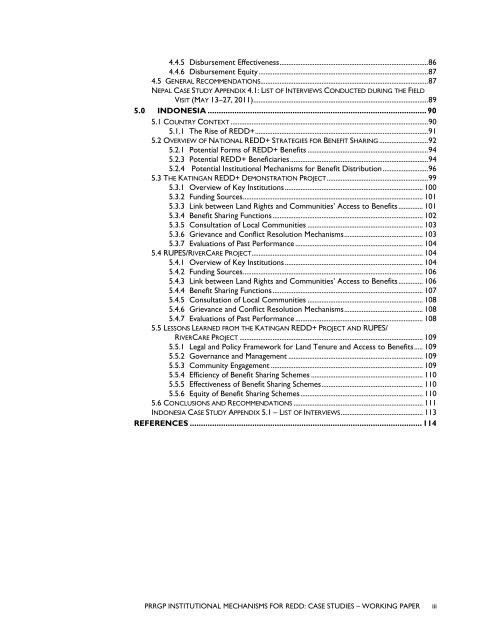Institutional Mechanisms for REDD+ - Case Studies Working Paper
Institutional Mechanisms for REDD+ - Case Studies Working Paper
Institutional Mechanisms for REDD+ - Case Studies Working Paper
You also want an ePaper? Increase the reach of your titles
YUMPU automatically turns print PDFs into web optimized ePapers that Google loves.
4.4.5 Disbursement Effectiveness ..................................................................................... 86<br />
4.4.6 Disbursement Equity ................................................................................................. 87<br />
4.5 GENERAL RECOMMENDATIONS................................................................................................ 87<br />
NEPAL CASE STUDY APPENDIX 4.1: LIST OF INTERVIEWS CONDUCTED DURING THE FIELD<br />
VISIT (MAY 13–27, 2011) .................................................................................................... 89<br />
5.0 INDONESIA .................................................................................................. 90<br />
5.1 COUNTRY CONTEXT ................................................................................................................. 90<br />
5.1.1 The Rise of <strong>REDD+</strong> ................................................................................................... 91<br />
5.2 OVERVIEW OF NATIONAL <strong>REDD+</strong> STRATEGIES FOR BENEFIT SHARING ............................ 92<br />
5.2.1 Potential Forms of <strong>REDD+</strong> Benefits ..................................................................... 94<br />
5.2.3 Potential <strong>REDD+</strong> Beneficiaries ............................................................................... 94<br />
5.2.4 Potential <strong>Institutional</strong> <strong>Mechanisms</strong> <strong>for</strong> Benefit Distribution .......................... 96<br />
5.3 THE KATINGAN <strong>REDD+</strong> DEMONSTRATION PROJECT .......................................................... 99<br />
5.3.1 Overview of Key Institutions ............................................................................... 100<br />
5.3.2 Funding Sources ....................................................................................................... 101<br />
5.3.3 Link between Land Rights and Communities’ Access to Benefits .............. 101<br />
5.3.4 Benefit Sharing Functions ...................................................................................... 102<br />
5.3.5 Consultation of Local Communities .................................................................. 103<br />
5.3.6 Grievance and Conflict Resolution <strong>Mechanisms</strong> ............................................. 103<br />
5.3.7 Evaluations of Past Per<strong>for</strong>mance ......................................................................... 104<br />
5.4 RUPES/RIVERCARE PROJECT .................................................................................................. 104<br />
5.4.1 Overview of Key Institutions ............................................................................... 104<br />
5.4.2 Funding Sources ....................................................................................................... 106<br />
5.4.3 Link between Land Rights and Communities’ Access to Benefits .............. 106<br />
5.4.4 Benefit Sharing Functions ...................................................................................... 107<br />
5.4.5 Consultation of Local Communities .................................................................. 108<br />
5.4.6 Grievance and Conflict Resolution <strong>Mechanisms</strong> ............................................. 108<br />
5.4.7 Evaluations of Past Per<strong>for</strong>mance ......................................................................... 108<br />
5.5 LESSONS LEARNED FROM THE KATINGAN <strong>REDD+</strong> PROJECT AND RUPES/<br />
RIVERCARE PROJECT ......................................................................................................... 109<br />
5.5.1 Legal and Policy Framework <strong>for</strong> Land Tenure and Access to Benefits ..... 109<br />
5.5.2 Governance and Management ............................................................................. 109<br />
5.5.3 Community Engagement ....................................................................................... 109<br />
5.5.4 Efficiency of Benefit Sharing Schemes ................................................................ 110<br />
5.5.5 Effectiveness of Benefit Sharing Schemes .......................................................... 110<br />
5.5.6 Equity of Benefit Sharing Schemes ...................................................................... 110<br />
5.6 CONCLUSIONS AND RECOMMENDATIONS .......................................................................... 111<br />
INDONESIA CASE STUDY APPENDIX 5.1 – LIST OF INTERVIEWS ............................................... 113<br />
REFERENCES ........................................................................................................ 114<br />
PRRGP INSTITUTIONAL MECHANISMS FOR REDD: CASE STUDIES – WORKING PAPER iii

















